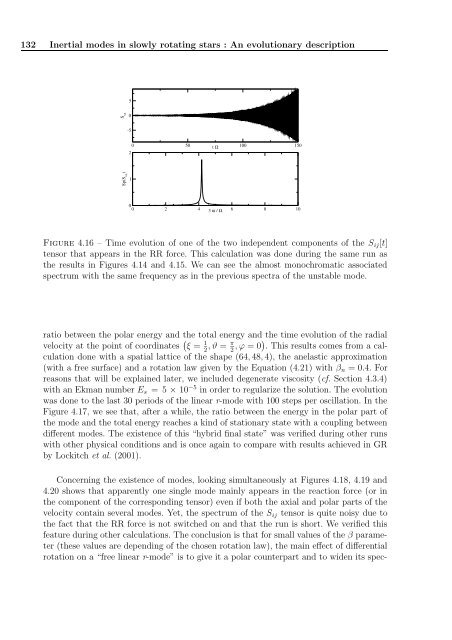Ecole doctorale de Physique de la région Parisienne (ED107)
Ecole doctorale de Physique de la région Parisienne (ED107)
Ecole doctorale de Physique de la région Parisienne (ED107)
You also want an ePaper? Increase the reach of your titles
YUMPU automatically turns print PDFs into web optimized ePapers that Google loves.
132 Inertial mo<strong>de</strong>s in slowly rotating stars : An evolutionary <strong>de</strong>scription<br />
S xx<br />
Sp(S xx )<br />
5<br />
0<br />
-5<br />
2<br />
1<br />
0 50 100 150<br />
t Ω<br />
0<br />
0 2 4 3 ω / Ω 6 8 10<br />
Figure 4.16 – Time evolution of one of the two in<strong>de</strong>pen<strong>de</strong>nt components of the Sij[t]<br />
tensor that appears in the RR force. This calcu<strong>la</strong>tion was done during the same run as<br />
the results in Figures 4.14 and 4.15. We can see the almost monochromatic associated<br />
spectrum with the same frequency as in the previous spectra of the unstable mo<strong>de</strong>.<br />
ratio between the po<strong>la</strong>r energy and the total energy and the time evolution of the radial<br />
velocity at the point of coordinates ξ = 1 π , ϑ = 2 2 , ϕ = 0 . This results comes from a calcu<strong>la</strong>tion<br />
done with a spatial <strong>la</strong>ttice of the shape (64, 48, 4), the ane<strong>la</strong>stic approximation<br />
(with a free surface) and a rotation <strong>la</strong>w given by the Equation (4.21) with βn = 0.4. For<br />
reasons that will be exp<strong>la</strong>ined <strong>la</strong>ter, we inclu<strong>de</strong>d <strong>de</strong>generate viscosity (cf. Section 4.3.4)<br />
with an Ekman number Es = 5 × 10−5 in or<strong>de</strong>r to regu<strong>la</strong>rize the solution. The evolution<br />
was done to the <strong>la</strong>st 30 periods of the linear r-mo<strong>de</strong> with 100 steps per oscil<strong>la</strong>tion. In the<br />
Figure 4.17, we see that, after a while, the ratio between the energy in the po<strong>la</strong>r part of<br />
the mo<strong>de</strong> and the total energy reaches a kind of stationary state with a coupling between<br />
different mo<strong>de</strong>s. The existence of this “hybrid final state” was verified during other runs<br />
with other physical conditions and is once again to compare with results achieved in GR<br />
by Lockitch et al. (2001).<br />
Concerning the existence of mo<strong>de</strong>s, looking simultaneously at Figures 4.18, 4.19 and<br />
4.20 shows that apparently one single mo<strong>de</strong> mainly appears in the reaction force (or in<br />
the component of the corresponding tensor) even if both the axial and po<strong>la</strong>r parts of the<br />
velocity contain several mo<strong>de</strong>s. Yet, the spectrum of the Sij tensor is quite noisy due to<br />
the fact that the RR force is not switched on and that the run is short. We verified this<br />
feature during other calcu<strong>la</strong>tions. The conclusion is that for small values of the β parameter<br />
(these values are <strong>de</strong>pending of the chosen rotation <strong>la</strong>w), the main effect of differential<br />
rotation on a “free linear r-mo<strong>de</strong>” is to give it a po<strong>la</strong>r counterpart and to wi<strong>de</strong>n its spec-
















